17.05.2025 by Viktor Siebert
Extensive Repair of the Okuma VAC5-D22 Spindle Drive
Some customers are keen to understand exactly how a repair price is calculated. This was precisely the question recently posed by a customer from Dortmund, who had successfully built his own company and highly values transparency and order. His question was entirely justified, as calculating the costs of high-quality repairs is indeed complex.
In fact, some repair companies juggle their prices. Only a few businesses can offer fixed-price repairs because several conditions must first be met:
- Skilled employees who possess both electronic expertise and practical craftsmanship.
- Experience in repairing identical or similar device types.
- Organized procurement and a well-managed spare parts inventory.
- Comprehensive testing facilities to thoroughly verify repairs.
- Precise and orderly documentation of repair steps.
- Thoughtful and efficient processes throughout the entire company.
- Ability to precisely calculate costs.
Meeting all these conditions is by no means easy. Particularly with this spindle drive – the Okuma VAC5-D22 (also known as U1233-0006 or VACV-D22) – repairs are exceptionally complex. The unit itself is heavy and consists of numerous components and assemblies, and the testing procedures involved are both extensive and challenging. Therefore, a repair price of several thousand euros is justified.
Some competitors in our industry take a different approach: they deliberately avoid publishing prices, instead first determining over the phone the identity of the customer and their willingness to pay. Occasionally, online providers attract customers with low prices because these customers hope for inexpensive offers or even miracles.
At Industrypart GmbH, however, we were able to convince our Dortmund-based customer through transparency and clearly documented steps.
Repair Process and Scope of Work
The following tasks were performed on the device (a summary for illustration):
- Upon arrival, the device was logged, photographed, and checked according to a detailed checklist. It was then fully connected to our testing equipment, where we successfully replicated the fault described by the customer. (Approx. 2 hours)
- A cost estimate was prepared and confirmed by the customer – in this instance as a fixed price.
- The unit was then completely disassembled, all parts thoroughly cleaned, and subsequently dried in a drying cabinet. The direct working time for this step was about 2 hours, with an additional drying time of 8 hours.
- Meanwhile, the necessary components were gathered from our inventory and handed over to the technician.
- Circuit boards were proactively refurbished; electrolytic capacitors (Elkos), SMD components, and current measurement modules were replaced. Particular attention was paid to the power board, where defective components were specifically replaced. (8 hours)
- Additional critical components, such as transistor modules and buffer capacitors, were replaced. While some parts were confirmed defective, we proactively replaced all relevant components as a precaution. (3 hours)
- Finally, the unit was reassembled and rigorously tested. It underwent a comprehensive load test on our equipment, simulating various speeds and directional changes. The full-load test lasted approximately one hour, followed by careful documentation on checklists and repair records. (4 hours)
In conclusion, the customer was informed, and the device was securely packaged on a pallet and shipped (approx. 1 hour).
The total working time was around 20 hours. Additional costs of approximately €1,500 arose for high-quality replacement parts, including transistor modules, buffer capacitors, fans, electrolytic capacitors, SMD components, current measurement modules, and miscellaneous small materials. Costs associated with the use of tools and specialized testing equipment were also factored in.
To optimize our internal processes, we have developed a software module specifically designed to precisely calculate repair prices. We would gladly share more information upon request.
Conclusion
High-quality repairs require considerable time, extensive technical expertise, premium replacement parts, comprehensive testing facilities, and skilled craftsmanship. Above all, they demand honesty and transparency towards the customer. These are precisely the values that we embody at Industrypart GmbH, distinguishing us from other providers.
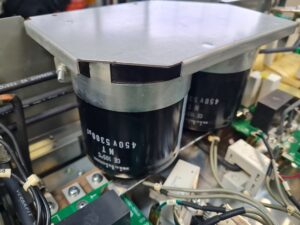
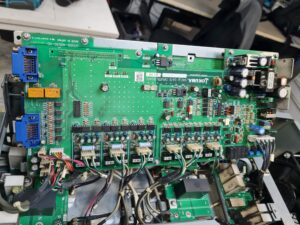
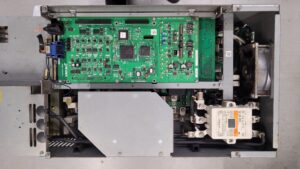
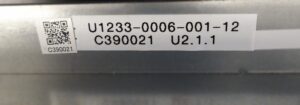
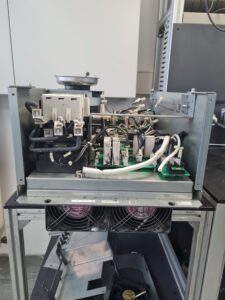
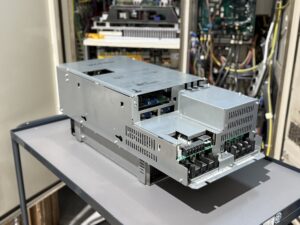
Price and Delivery Time for Okuma VAC5-D22 U1233-0006 oder VACV-D22
For more information about our Okuma repairs, please click here.
📞 Feel free to contact us if you have any questions regarding your Mitsubishi drive technology. Our experienced team is always ready to provide you with expert advice and support.
Device Description and Technical Data
| Property | Description |
|---|
| Device Type | Spindle Drive Unit |
| Model Number | Okuma VAC5-D22 |
| Alternative Numbers | U1233-0006, VACV-D22 |
| Input Voltage | 3 x AC 180–220 V, 50/60 Hz |
| Control Interface | Optical interface |
| Fuses | FR = 5.0 A, FS = 5.0 A, FT = 5.0 A |
| Communication | Optical interface with NC control unit |
2. Functional Description
The VAC5-D22 unit controls spindle speed, torque, and positioning within CNC machining centers. It primarily consists of power and control PCBs, which are connected via optical connections to the NC control unit. The unit ensures precise speed regulation, rapid direction changes, and can operate in spindle or C-axis control mode.
Control commands are transmitted via optical signals. Internal electronics continuously monitor current, voltage, temperature, and positional signals, ensuring safe operation through various protective circuits.
3. Alarm Messages and Troubleshooting (Excerpt)
| Alarm No. | Alarm Description | Cause | Recommended Action |
|---|
| 01 | PG counting error | Faulty or improperly adjusted encoder | Adjust or replace encoder |
| 02 | Motor overspeed | Faulty resolver or encoder | Check or replace resolver or encoder |
| 03 | APA speed (spindle overspeed) | Encoder improperly adjusted or defective | Inspect, adjust, or replace encoder |
| 10 | Motor wire overcurrent | Short circuit, faulty wiring, or motor defect | Inspect wiring and motor, replace if needed |
| 11 | Inverter bridge short | Short circuit in motor or wiring | Inspect wiring and motor, replace if needed |
| 12 | Regenerator IGBT short | Defective power module or power outage | Replace power module or inspect power supply |